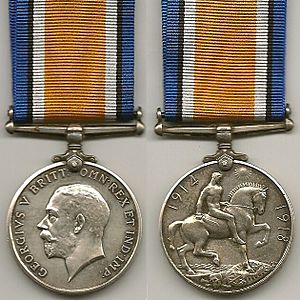British War Medal facts for kids
Quick facts for kids British War Medal |
|
|---|---|
 |
|
| Awarded by the Monarch of the United Kingdom and the British Dominions, and Emperor of India | |
| Country | |
| Type | Campaign medal |
| Eligibility | British and Imperial forces |
| Awarded for | Campaign service |
| Campaign(s) | First World War |
| Statistics | |
| Established | 26 July 1919 |
| Total awarded | 6,500,000 silver 110,000 bronze |
| Precedence | |
| Next (higher) | 1914–15 Star |
| Next (lower) | Victory Medal (United Kingdom) Victory Medal (South Africa) |
Ribbon bar |
|
The British War Medal was a special medal given to soldiers. It honored those who fought in the First World War. This war took place from 1914 to 1918.
The medal was first planned for people who served between August 5, 1914, and November 11, 1918. However, this was later changed. It included service up to 1920. This was because many people were still in danger. They were clearing landmines and sea mines after the war ended.
What is the British War Medal?
The British War Medal, often called the BWM, was given to many people. This included officers and soldiers from the Royal Marines, Royal Navy, and the Army. It also went to members of the Dominion and Colonial Forces. These forces were the armies from other parts of the British Empire.
To get the medal, a person had to leave their home country. They had to be on military duty for the British Empire.
How Many Medals Were Given Out?
Over 6.5 million British War Medals were awarded. Most of these medals were made of silver. A smaller number, about 110,000, were made of bronze. The bronze medals are much rarer.
All the medals are round. They have different pictures on each side. Each side of a medal is called a face. The side with a person's head is the obverse. The other side is called the reverse. The picture of a head and shoulders is known as a bust.
The Front of the Medal (Obverse)
The obverse side of the medal shows a bust of King George V. He was the King of the United Kingdom at the time. The picture shows him looking to the left.
Around the King's picture, there is writing. It says 'GEORGIVS V BRITT : OMN : REX ET IND : IMP :'. The 'V' in 'GEORGIVS' is read as a 'U'. This writing is shortened Latin. In English, it means 'George the 5th, King of all the British people and Emperor of India'.
The Back of the Medal (Reverse)
The reverse side of the medal shows a man riding a rearing horse. This man is Saint George. He is the patron saint of England. He is holding a short sword. This image was meant to show the great strength needed to win the First World War.
The horse is stepping on a shield. This shield has the emblem of Prussia and the Central Powers. These were the enemies that the British and their Allies fought. The horse is also stepping on a skull and cross-bones. A rising sun, called the Victory Sun, is near St. George's head. The years '1914' and '1918' are also shown on this side.
Medal Details and Ribbon
The name of the soldier, their regiment, and their army identification number were carved around the rim (edge) of each medal.
Each medal also came with a special ribbon. This ribbon was made of silk. It had a thick golden-yellow stripe in the middle. On either side of this stripe were thinner stripes. These stripes were white, then black, and finally Royal blue on the very edges.
Images for kids

